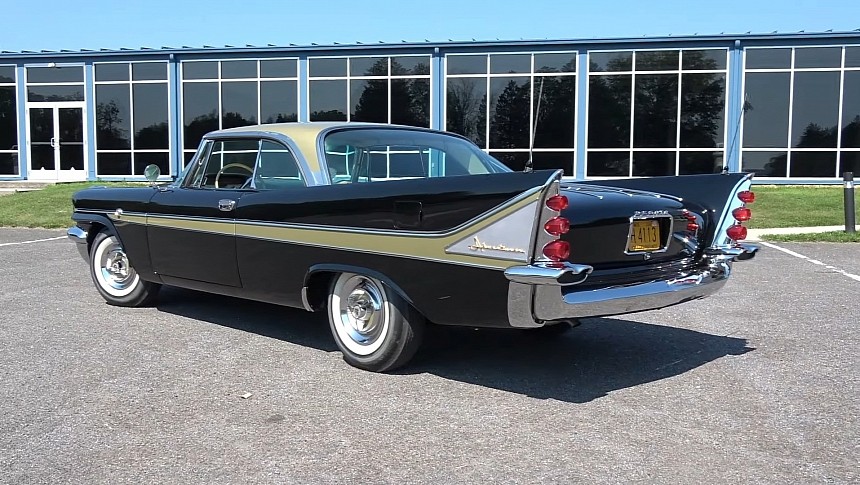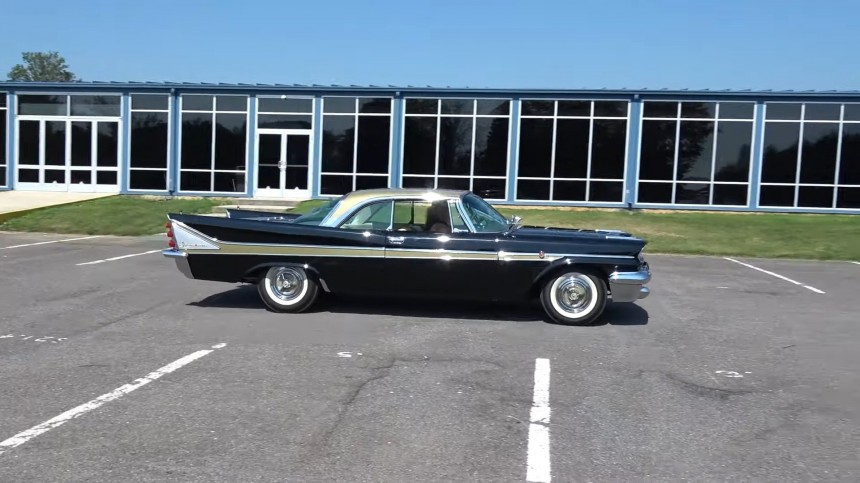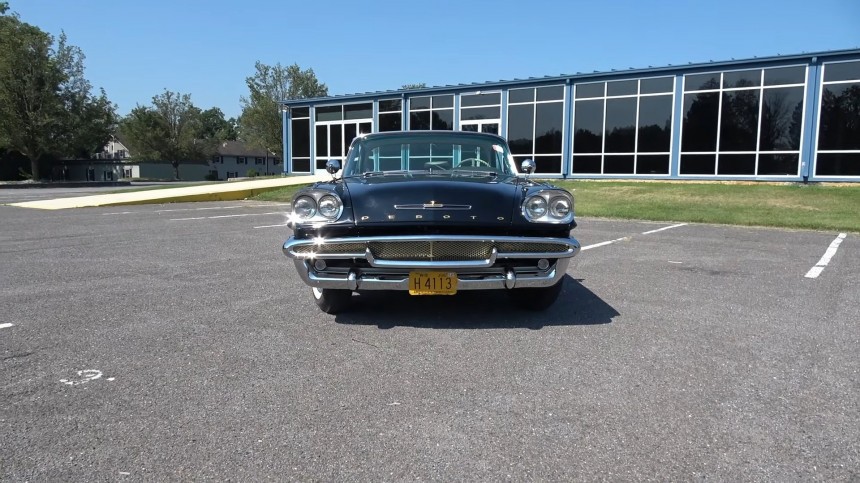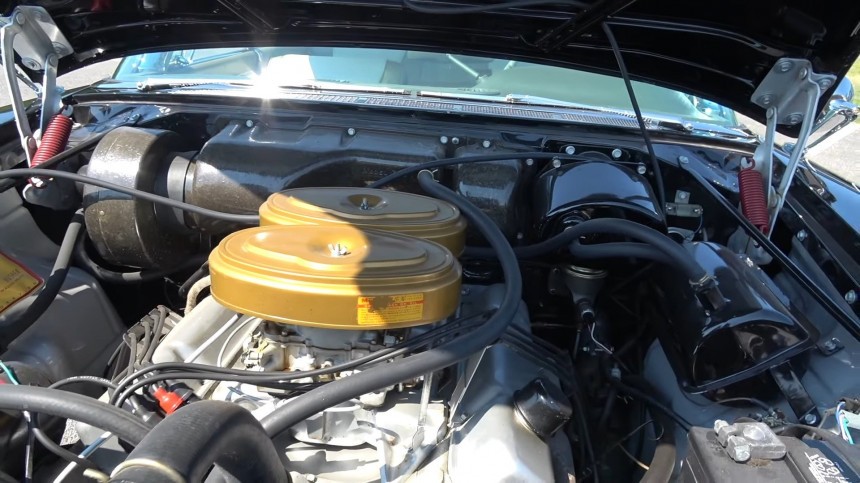“If you actually lean on it hard enough to kick in the second four-barrel, it'll chirp the tires going in the second and third gear.” The statement is made regarding a 65-year-young American legend, the only one known to exist in 2023: a black 1958 DeSoto Adventurer hardtop. Despite being the victim of a circumstantially adverse period, the car came as the company’s swan song before going into a downward spiral of termination.
In 1958, a prospective American buyer interested in purchasing a new automobile could have driven away in a brand-new Chrysler vehicle with a simple exchange: eight de Sotos for one. No, it wasn’t a hoax that the carmaker used, nor some other type of scheme. But the price of a DeSoto Adventurer model would have been covered by eight Federal Reserve legal tender $500 bills, which had an engraving of the crossing of the Mississippi by Hernando de Soto.
Officially introduced as a Chrysler Division in 1928, when the corporation exploded from just one brand to four in just two summer months, between June and August, DeSoto was initially placed in the bottom half of the price range. Above Plymouth but below Dodge and Chrysler, DeSoto ranked up five years later, switching places with Dodge and becoming Mopar’s second-most pricey offer.
In 1955, when Imperial became Chrysler’s fifth division, DeSoto fell in the middle of the price hierarchy, and it stayed there for the remainder of its automotive life. On November 30, 1960, the last DeSoto automobile was assembled, and an iconic name was parked forever in the history books. Before exiting the stage, the brand left a legacy that continues to entice car nuts today.
The Adventurer of the 1950s is one of – if not the most – valuable Mopars for collectors of 2023, and the reason is pretty straightforward: rarity. Notably the 1958 examples, of which only 350 hardtops and 82 convertibles were assembled. These nearly surreal numbers could very well rival the production run of a coachbuilding shop that only makes bespoke bodies. There is a reasonable but surprising explanation for this, wrapped in the shroud of an adverse economy: quality.
Chryslers of the 50s were famous for several things: their Virgil Exner “100 million-dollar” looks, their strict quality control inspectors, their engineering pioneering, and their 1957 DeSoto flop. The corporation was fighting hard to stay ahead of the Detroit rivals in design and rushed the new models to production. The direct result of this hurry-up elan came as a downpour of reports of cars rusting out within months of being built.
Other poor assembly mishaps were common, too, putting deep wrinkles on the image of DeSoto. When the '58s came out, most of those issues had been solved, but the perception was still bleeding profusely. With the economy already knocked down by the Eisenhower recession, DeSoto’s sales for that fatidic year nosedived by 78%. ‘Catastrophe’ is too mild of a word to describe the situation, and the Mopar make never recovered after that blow.
Adding to this, an uninspired internal decision from Chrysler brass also dragged the brand down. The neighboring brands of DeSoto in the corporation’s hierarchy, Dodge and Chrysler, were allowed to expand and overlap their own offers with DeSoto. Dodge proposed fancy cars, Chrysler had budget-friendly products, and that fratricidal competition didn’t help the middle-of-the-road nameplate at all.
Nonetheless, some good things happened in 1958: the Turboflash wedge V8 replaced the hemispherical engines (the first-generation HEMIs that weren’t marketed as such but were outstanding performers). The new eight-pot was lighter but equally potent. At 361 cubic inches (just five over the hemi) - or 5.9 metric liters – the engine delivered the same 345 hp as the dome-head V8, thanks to its 10.25:1 compression and dual quads. 400 lb-ft of torque (542 Nm) was quite enough to bruise the rubbers.
I’m not adding lipstick on a DeSoto; the tire-tormenting claim comes from an actual owner – the man driving his 1958 Adventurer hardtop in the video attached to this article. Filmed in July, this Mopar’s sequential carburetion will put the hammer down hard on the rear once the engine gets up to speed. Surprisingly, due to the lower numerical gearing of the rear, the drive-off isn’t engulfed in dramatic clouds of smoke, but when the secondaries of the first carb kick in, the going gets not tough but fast.
It then gets really fast when the second four-barrel is activated, making that red-stripe speedometer try and reach the 150-mph mark at the far right of the dial. Similarly, the gasoline indicator would most likely try and make contact with the speed ribbon by diving to the left of the gauge, in the “E” zone of the wallet-burning instrument.
The man has had his Desoto since 2013 (he is the owner of another example, the ’59 with a 383-CID V8 in it – the famous 6.3-liter Chrysler engine that derived directly, through over-boring, from the ’58 Turboflash wedge. Play the second video to see Mr. Frank's other DeSoto). This car is a restoration – it actually came in boxes when the current owner (and re-assembler) bought it. The battery is not correct for the vehicle as per factory-original stats, and the mufflers are an excellent day-two addition. Still, otherwise, the DeSoto is as close to the sales brochures as it comes.
The three-speed TorqueFlite automatic – with raging cool push-button controls – is probably one of the best-known features of Mopars of the 50s, apart from their looks. Available in four color combinations of white, black, and gold with black or white sweep. The car starring in this story is the only known black hardtop from the 1958 DeSoto Adventurer production run.
The original owners wanted to pass the car down to someone with the TLC-no-object approach to owning the orphan Mopar. That’s why they didn’t go the usual route – advertising the car in magazines and websites – but instead relied on the tried and tested method of spreading the word the old-fashioned way. Miraculously, the “I know someone who knows someone who has heard about” method paid off for Bruce Frank – the current owner – who learned about his black DeSoto (the other one, the ’59, is white) from friends. He bought the car and put it back to its factory blue-printed condition – and we should all tip our hats to him for his job.
Officially introduced as a Chrysler Division in 1928, when the corporation exploded from just one brand to four in just two summer months, between June and August, DeSoto was initially placed in the bottom half of the price range. Above Plymouth but below Dodge and Chrysler, DeSoto ranked up five years later, switching places with Dodge and becoming Mopar’s second-most pricey offer.
In 1955, when Imperial became Chrysler’s fifth division, DeSoto fell in the middle of the price hierarchy, and it stayed there for the remainder of its automotive life. On November 30, 1960, the last DeSoto automobile was assembled, and an iconic name was parked forever in the history books. Before exiting the stage, the brand left a legacy that continues to entice car nuts today.
Chryslers of the 50s were famous for several things: their Virgil Exner “100 million-dollar” looks, their strict quality control inspectors, their engineering pioneering, and their 1957 DeSoto flop. The corporation was fighting hard to stay ahead of the Detroit rivals in design and rushed the new models to production. The direct result of this hurry-up elan came as a downpour of reports of cars rusting out within months of being built.
Other poor assembly mishaps were common, too, putting deep wrinkles on the image of DeSoto. When the '58s came out, most of those issues had been solved, but the perception was still bleeding profusely. With the economy already knocked down by the Eisenhower recession, DeSoto’s sales for that fatidic year nosedived by 78%. ‘Catastrophe’ is too mild of a word to describe the situation, and the Mopar make never recovered after that blow.
Nonetheless, some good things happened in 1958: the Turboflash wedge V8 replaced the hemispherical engines (the first-generation HEMIs that weren’t marketed as such but were outstanding performers). The new eight-pot was lighter but equally potent. At 361 cubic inches (just five over the hemi) - or 5.9 metric liters – the engine delivered the same 345 hp as the dome-head V8, thanks to its 10.25:1 compression and dual quads. 400 lb-ft of torque (542 Nm) was quite enough to bruise the rubbers.
I’m not adding lipstick on a DeSoto; the tire-tormenting claim comes from an actual owner – the man driving his 1958 Adventurer hardtop in the video attached to this article. Filmed in July, this Mopar’s sequential carburetion will put the hammer down hard on the rear once the engine gets up to speed. Surprisingly, due to the lower numerical gearing of the rear, the drive-off isn’t engulfed in dramatic clouds of smoke, but when the secondaries of the first carb kick in, the going gets not tough but fast.
The man has had his Desoto since 2013 (he is the owner of another example, the ’59 with a 383-CID V8 in it – the famous 6.3-liter Chrysler engine that derived directly, through over-boring, from the ’58 Turboflash wedge. Play the second video to see Mr. Frank's other DeSoto). This car is a restoration – it actually came in boxes when the current owner (and re-assembler) bought it. The battery is not correct for the vehicle as per factory-original stats, and the mufflers are an excellent day-two addition. Still, otherwise, the DeSoto is as close to the sales brochures as it comes.
The three-speed TorqueFlite automatic – with raging cool push-button controls – is probably one of the best-known features of Mopars of the 50s, apart from their looks. Available in four color combinations of white, black, and gold with black or white sweep. The car starring in this story is the only known black hardtop from the 1958 DeSoto Adventurer production run.
The original owners wanted to pass the car down to someone with the TLC-no-object approach to owning the orphan Mopar. That’s why they didn’t go the usual route – advertising the car in magazines and websites – but instead relied on the tried and tested method of spreading the word the old-fashioned way. Miraculously, the “I know someone who knows someone who has heard about” method paid off for Bruce Frank – the current owner – who learned about his black DeSoto (the other one, the ’59, is white) from friends. He bought the car and put it back to its factory blue-printed condition – and we should all tip our hats to him for his job.























































